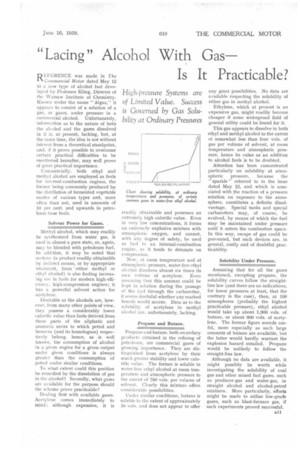Lacing" Alcohol With Gas Is It Practicable?
Page 45

If you've noticed an error in this article please click here to report it so we can fix it.
High-pressure Systems are of Limited Value. Success is Governed by Gas Solubility at Ordinary Pressures
REFERENCE was made in The Commercial Motor dated May 12 to a new type of alcohol fuel developed by Professor Kling, Director of the Warsaw Institute of Chemistry. Known under the name " Algaz," it appears to consist of a solution of a gas, or gases, under pressure in a commercial alcohol. Unfortunately, information as to the nature of both the alcohol and the gases dissolved in it is, at present, lacking, but, at the same time, the idea is not without interest from a theoretical standpoint, and, if it prove possible to overcome certain practical difficulties to be mentioned hereafter, may well prove Of great practical importance.
Commercially, both ethyl and methyl alcohol are employed as fuels for internal-combustion engines, the former being commonly produced by the distillation of fermented vegetable matter of various types and, more often than not, used in amounts of 10 per cent. and upwards in petroleum-base fuels.
Solvent Power for Gases.
Methyl alcohol, which may readily be synthesized from water gas, is used in almost a pure state, or, again, may be blended with petroleum fuel. In addition, it may be noted that acetone (a product readily obtainable by indirect means, or by appropriate treatment, from 'either methyl or ethyl alcohol) is also finding increasing use in fuels for modern high-efficiency, high-compression engines; it has a powerful solvent action for acetylene.
Desirable as the alcohols are, however, from many other points of view, they possess a considerably lower calorific value than fuels derived from those parts of the aliphatic and aromatic series to which petrol and benzene (and its homologues) respectively belong, hence, as is well known, the consumption of alcohol in a given engine for a givenoutput under given conditions is always greater than the consumption of Petrol under similar conditions.
To what extent could this position be remedied by the dissolution of gas in the alcohol? Secondly, what gases are available for the purpose should the scheme prove practicable?
Dealing first with available gases_ Acetylene comes immediately to mind: although expensive, it is
readily obtainable and possesses an extremely high calorific value. Even in very low concentrations, it forms an extremely explosive mixture with atmospheric oxygen, and cannot, with any degree of safety, be used as fuel in an internal-combustion engine, as it tends to detonate on compression.
Now, at room temperature and at atmospheric pressure, water-free ethyl alcohol dissolves almost six times its own volume of acetylene. Even assuming that this amount could be kept in solution during the passage of the fuel through the carburetter, it seems doubtful whether any marked benefit would accrue. Data as to the solubility of acetylene in methyl alcohol are, unfortunately, lacking.
Propane and Butane.
Propane and butane, both secondary products obtained in the refining of petroleum, are commercial gases of growing importance. They are distinguished from acetylene by their much greater stability and lower calorific value. The former is soluble in water-free ethyl alcohol at room temperature and atmospheric pressure to the extent of 790 vols. per volume of solvent. Clearly this mixture offers considerable possibil ities.
Under similar conditions, butane is soluble to the extent of approximately vols, and does not appear to offer any great possibilities. No data are available respecting the solubility of either gas in methyl alcohol.
Ethylene, which at present is an expensive gas, might readily become cheaper if some widespread field of general utility could be found for it.
This gas appears to dissolve in both ethyl and methyl alcohol to the extent of somewhat less than four vols, of gas per volume of solvent, at room temperature and atmospheric pressure, hence its value as an addition to alcohol fuels is to be doubted.
Attention has been concentrated particularly on solubility at atmospheric pressure, because the " sparkle " referred to in the issue dated May 12, and which is associated with the reaction of a pressure solution on exposure to the atmosphere, constitutes a definite disadvantage. Special tanks and special carburetters may, of course, be evolved, by means of which the fuel may be maintained under pressure until it enters the combustion space. In this way, escape of gas could be prevented, but such devices are, in general, costly and of doubtful practicability.
Solubility Under Pressure.
Assuming that for all the gases mentioned, excepting propane, the solubility curves follow the straightline law (and there are no indications, for lower pressures at least, -that the contrary is the case), then, at 100 atmospheres (probably the highest practicable pressure), ethyl alcohol would take up about 1,900 vols. of butane, or about 600 vols, of acetylene. The former figure sounds useful, more especially as such large amounts of butane are available, but the latter would hardly warrant the explosion hazard entailed. Propane would be unlikely to follow the straight-line law.
Although no data are available, it might possibly be worth while investigating the solubility of coal gas and other mixed fuel gases. such as producer-gas and water-gas, in straight alcohol and alcohol-petrol mixtures. More particularly, efforts might be made to utilize low-grade gases, such as blast-furnace gas, if such experiments proved successful.




















































































